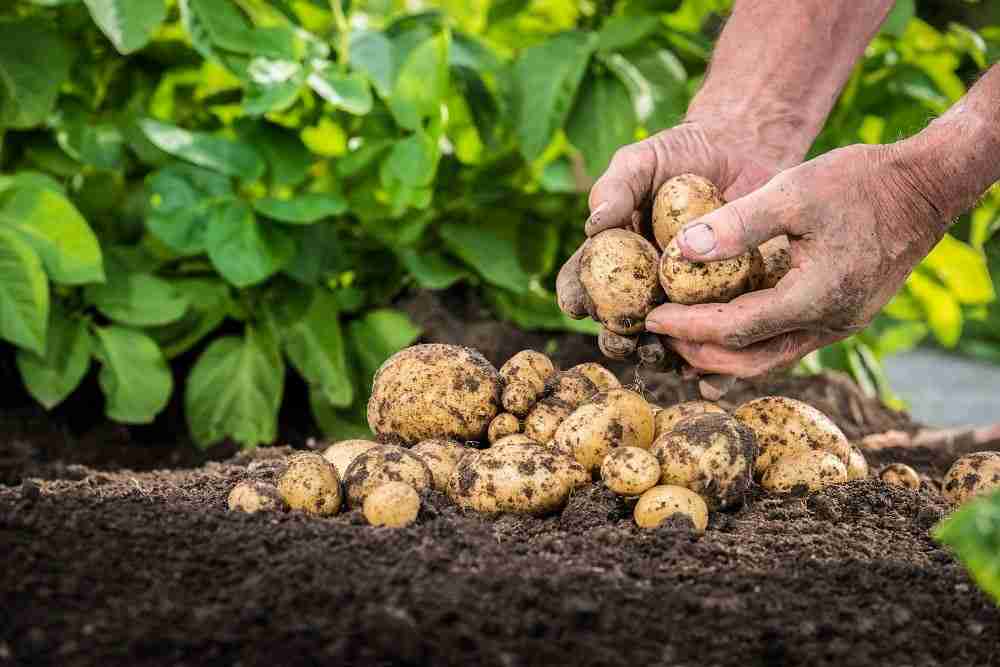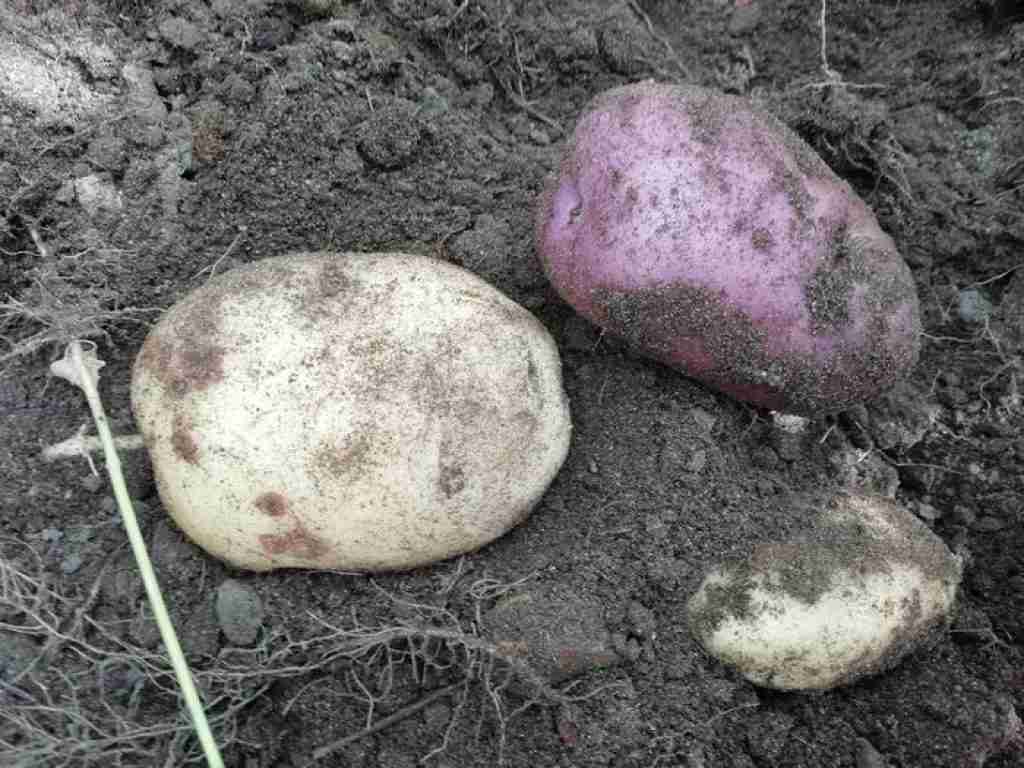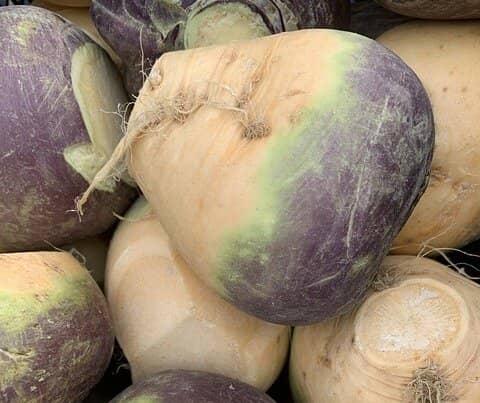Choosing the best place to plant your potatoes will be different for everyone. We all have different areas available to grow things in.
Some people may have fields, allotments, or a large vegetable garden. Others may only have access to growing potatoes in a raised bed, and some may choose to grow potatoes in a tyre, or some other type of small container.
All these different physical locations will have their separate conditions to consider. There are a few ground rules which should apply before choosing where to plant potatoes.
How to grow potatoes
For an in-depth article covering all aspects of potato growing please see my article How to grow your own potatoes.
What type of soil conditions do potatoes like
The soil should have good drainage and not be prone to waterlogging. Potatoes that sit in water-logged soil will rot.
There are many different soil types but generally, a well-drained loam works best. Tilling heavy clay soil can be physically demanding and it retains too much moisture and tends to dry out hard. This makes it difficult for the tubers to grow.
Sandy soil generally loses water too quickly and can cause the potatoes drought stress. This causes skin blemishes such as scab.
A slightly acidic soil pH of 5.0 to 5.5 is optimum for healthy tubers and will also minimise scab.
Introduce farmyard manure to break up the soil. This will provide nutrients and minerals for the potatoes to grow. I cover this topic in another post on choosing the best fertiliser for potatoes.
There are many places you can grow potatoes – I will list a few below.
Growing potatoes in bags
Grow bags and planters are great for growing potatoes if you don’t have much space.
These planter bags are very useful. You can grow all sorts of vegetables in them. The velcro side flap is really useful to check soil moisture levels as well as an aid for harvesting.
Add drainage holes
After making sure there are plenty of water drainage holes in your bag. (7-8 finger-sized holes per 450mm diameter) Fill your bag at least 6 inches 150mm from the bottom with good compost.
Place the seed into the soil
Then depending on the size of the bag, insert your seed potato into the compost with the eye or chit pointing upwards. Then fill to the top at least 6” or 150mm above the seed potato.
For larger bags, you may be able to plant two seed potatoes. Generally, you want to leave at least 300mm diameter between each tuber, both up and down and left and right.
Water the soil
Give the compost a light watering and place it in an open area. Ensure plenty of sunlight (for heat and light) and away from hedges and under trees.
Growing potatoes indoors will mean there will be no air to blow through the leaves of the plant. Unfortunately, airflow is beneficial to blow away blight spores and keep your crop healthy. So allow plenty of ventilation if you have potatoes indoors.
Growing potatoes in raised beds
Another great place to grow potatoes would be in a raised bed.
Place your seed in rows remembering to keep each tuber roughly 300mm along the row and 300mm between the rows.
Make sure your raised bed has good drainage. If it doesn’t you can end up with a swamp of seed potatoes and soil. Raised beds can hold quite a bit of water in wet seasons.
You don’t need to own a vegetable garden nowadays to have a raised bed. This raised bed box would be great for growing potatoes, other vegetables, and herbs.
Growing potatoes in tyres
Growing potatoes in tyres is just like growing potatoes in bags. Tyres are good because they have a strong outer rim. You can stack them up high to hold a good depth of earth.
The more soil you have around potatoes the more nutrients they have and the more potential to grow big.
Another advantage of growing potatoes in tyres is they are very stable on the ground. They will not blow over easily like potatoes which are grown in a bag.
Potatoes grown in plastic bags can be very unstable. When they are reaching full foliage the leaves can be 2 to 3 feet above the top of the bag.
This makes them prone to being blown over in high winds, especially if they are in exposed areas.
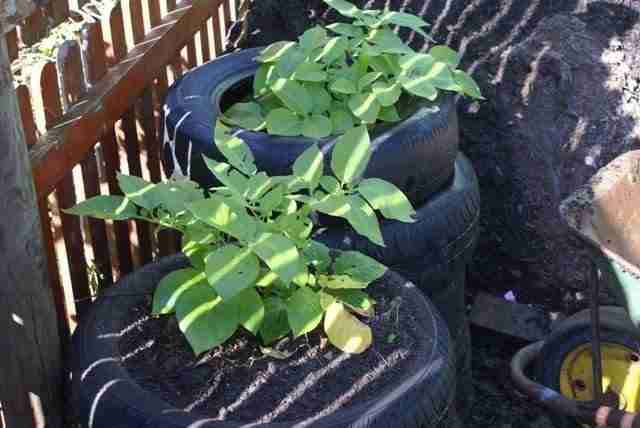
Tyres have rigid sides and a flat base. this makes them less likely to blow over.
The downside of using tyres is that they can hold too much water if they are sitting on a non-porous flat surface.
I would advise you to set your tyres up off the ground using short wooden boards or bricks- anything to keep the bottom of the tyre up off the ground to allow excess water to drain out.
Don’t stack your tyres too high as they will become unstable. 3 to 4 tires high is enough.
While it is true the more soil you have around your potatoes the more nutrients are available and a better chance of a higher yield is possible- there is a limit to this.
It is better to have a large diameter tyre stacked 2 high than 4 small tyres stacked high.
Using larger-diameter tyres will provide more stability.
Growing potatoes in buckets
The same rules apply to growing potatoes in buckets as are applied to commercial growers /farmers growing potatoes
Make sure the compost or soil is at least 6 inches above below and to the sides of the seed potato.
Ensure the bucket has drainage holes- if they are on the bottom keep it up off the ground to let the water out or better still if the holes are in the sides also.
Keep it out in the open where the wind can blow through it and the sun can shine on it for most of the day and water it lightly on dry days- this will help prevent blight.
Growing potatoes in a vegetable garden
If you are growing your potatoes in a vegetable garden or an allotment (larger areas) then you should pay a bit more attention to soil conditions and drainage.
It is always a good idea to check that there are no broken drains or wet patches in your plot, If there are you should fix those first.
I would advise adding farmyard manure over the whole plot and digging or ploughing it deep – at least 10 inches or 250mm and leaving it over winter (the frost will help to break up the soil).
When spring arrives and you have your seed potatoes chitted and ready to plant, I would rotavate the whole plot at least twice making sure the soil is at a fine tilth and large stones are removed.
Now you can mark out your drills and plant your seed into rows at least 300mm apart making sure to mark the ends with a stick and card when different varieties are used.
When should I plant my potatoes?
You should plant early potatoes as soon as the ground heats up enough and preferably have the latest planting date in June or July at the latest.
We always aim to have our early potatoes planted before our turnips.
Harvesting potatoes
See us harvesting potatoes here:
If you have been able to keep blight away from your potatoes and they have started to die off on their own – this usually happens around September- October time, they will be ready for harvesting.
The tops will die back and then turn white (as can be seen in the above video). It is best to keep the potatoes in the ground until the weather gets a bit colder so that you won’t be storing them in warm conditions.
After they are dug you are best to store them in hessian bags or wooden boxes.
This is to allow plenty of air around them- you should be storing your potatoes in a dark cool dry room.
If direct sunlight gets at the potatoes it will turn them green (sunburn) and they will be inedible. If you store them somewhere warm and damp they will rot.
These are the kind of hessian bags I would store my potatoes in:
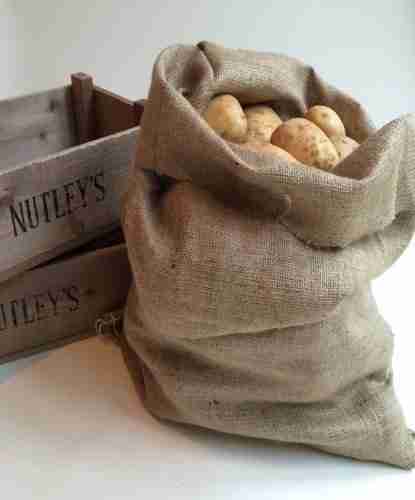
These are useful storage boxes that will last for a long time and have a convenient board on the side to mark your different potato varieties on them.
Or if you grow other vegetables, you can use these to store them in also. Great box.
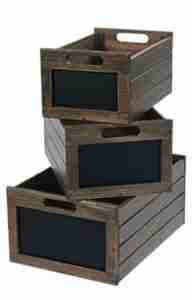
Try not to get too excited and harvest your potatoes early- let them grow and fill out. When you allow the potatoes to mature and ripen fully, they will taste even better!

